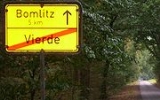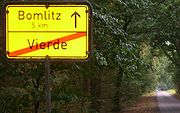
Vierde
Encyclopedia
Vierde is a village within the borough of Bad Fallingbostel
in Soltau-Fallingbostel district in the Heidmark
(southern part of the Lüneburg Heath
in the state of Lower Saxony
, Northern Germany
).
Vierde was an agricultural village for centuries and, for the most part, still is today. Until the 19th century the keeping of Heidschnucke
n (moorland sheep) was the main source of income for the heath farmers. Only once the hardpan
could be dealt with it was possible to cultivate crops, like grain and fruit trees, in order to generate new sources of income.
Long established families are closely linked to the history and development of the village. The oldest surnames include: 1379: Ghogeue, 1438: Bode 1438: Niegemeiger, 1438: de rode Cordesche, 1438: Metteke, 1438: Detmer: 1438: Eggerdeschen stede woste, 1528: Hans Lethsemann, 1528: Cordt Pruschhagen, 1528: Cordt tom Kampe, 1528: Dirick 1528: Enmers, 1899: Oelfke
. Large farms still bear witness to the development of these families today.

 As well as farming, the woods and the River Böhme, the Böhmeschlucht campsite, which is sited in the gorge of the same name, also stamps the character of Vierde. Vierde is located in the Heidmark
As well as farming, the woods and the River Böhme, the Böhmeschlucht campsite, which is sited in the gorge of the same name, also stamps the character of Vierde. Vierde is located in the Heidmark
, which was once the most beautiful part of the Lüneburg Heath. Large parts of the Heidmark were turned into a military training area in 1935/36 (nowadays the largest of its kind in Europe, the Bergen-Hohne Training Area
), and numerous villages disappeared from the map.
The people of Vierde make an effort to work together to achieve cohesion, something which is seen as very important. The successful Adolphsheide-Vierde Shooting Club plays a significant role in bringing folk together.
Since then the hill has been called the Hexenberg ("witch's hill").

Bad Fallingbostel
Bad Fallingbostel is the district town of the Heidekreis district in the German state of Lower Saxony. Since 1976 the town has had a state-recognised Kneipp spa and has held the title of Bad since 5 August 2002. It has close ties to Walsrode, a few miles to the west...
in Soltau-Fallingbostel district in the Heidmark
Heidmark
The Heidmark is an area of the Lüneburg Heath, much of which has not been accessible to the population since about 1935/1936. The establishment of a large military training area by the German armed forces, the Wehrmacht, as part of their rearmament and preparation for war resulted in the...
(southern part of the Lüneburg Heath
Lüneburg Heath
The Lüneburg Heath is a large area of heath, geest and woodland in northeastern part of the state of Lower Saxony in northern Germany. It forms part of the hinterland for the cities of Hamburg, Hanover, and Bremen and is named after the town of Lüneburg. Most of the area is a nature reserve...
in the state of Lower Saxony
Lower Saxony
Lower Saxony is a German state situated in north-western Germany and is second in area and fourth in population among the sixteen states of Germany...
, Northern Germany
Northern Germany
- Geography :The key terrain features of North Germany are the marshes along the coastline of the North Sea and Baltic Sea, and the geest and heaths inland. Also prominent are the low hills of the Baltic Uplands, the ground moraines, end moraines, sandur, glacial valleys, bogs, and Luch...
).
History
The first recorded mention of the village was around 1337. The name Vierde is derived from the four (vier) full-sized farms (Vollhöfen) that once formed the village of Vierde.Vierde was an agricultural village for centuries and, for the most part, still is today. Until the 19th century the keeping of Heidschnucke
Heidschnucke
The Heidschnucke is a group of three types of moorland sheep from northern Germany. Like a number of other types from Scandinavia and Great Britain, they are Northern European short-tailed sheep...
n (moorland sheep) was the main source of income for the heath farmers. Only once the hardpan
Hardpan
In soil science, agriculture and gardening, hardpan or ouklip is a general term for a dense layer of soil, usually found below the uppermost topsoil layer. There are different types of hardpan, all sharing the general characteristic of being a distinct soil layer that is largely impervious to water...
could be dealt with it was possible to cultivate crops, like grain and fruit trees, in order to generate new sources of income.
Long established families are closely linked to the history and development of the village. The oldest surnames include: 1379: Ghogeue, 1438: Bode 1438: Niegemeiger, 1438: de rode Cordesche, 1438: Metteke, 1438: Detmer: 1438: Eggerdeschen stede woste, 1528: Hans Lethsemann, 1528: Cordt Pruschhagen, 1528: Cordt tom Kampe, 1528: Dirick 1528: Enmers, 1899: Oelfke
Oelfke
is a German surname and a Plattdüütsch first name for boys.- Origin and meaning :The name Oelfke, name of farmers from the "Hohe Heidmark" of the administrative district Soltau-Fallingbostel in Lower-Saxony, Germany traces back to Ol, Oel=Adel , Od=Besitz , like Oleff, Oloff, Odulleib, that's the...
. Large farms still bear witness to the development of these families today.
Culture and Landscape


Heidmark
The Heidmark is an area of the Lüneburg Heath, much of which has not been accessible to the population since about 1935/1936. The establishment of a large military training area by the German armed forces, the Wehrmacht, as part of their rearmament and preparation for war resulted in the...
, which was once the most beautiful part of the Lüneburg Heath. Large parts of the Heidmark were turned into a military training area in 1935/36 (nowadays the largest of its kind in Europe, the Bergen-Hohne Training Area
Bergen-Hohne Training Area
Bergen-Hohne Training Area is a NATO military training area in the southern part of the Lüneburg Heath, in the state of Lower Saxony in northern Germany. It covers an area of , which makes it the largest military training area in Germany.It was established by the German armed forces, the...
), and numerous villages disappeared from the map.
The people of Vierde make an effort to work together to achieve cohesion, something which is seen as very important. The successful Adolphsheide-Vierde Shooting Club plays a significant role in bringing folk together.
The legend of the Hexenberg
The legend of the Hexenberg in Vierde has been passed down for generations. According to the legend:
A witch used to live in the Papenhaus. One day she died. She was to be buried on the hill. So her coffin was loaded onto a cart. The horses sweated under the load. At Leitzmann's they could go no further. Suddenly something moved in the coffin. It was opened quickly and... a sow jumped out.
Since then the hill has been called the Hexenberg ("witch's hill").
Literature

- Hans StuhlmacherHans StuhlmacherHans Albert Alexander Louis Carl Stuhlmacher was a German pedagogue, Wehrmacht officer and local historian.- Life and works :Hans Stuhlmacher was born on 16 May 1892 in Lüneburg, the son of a district court chancery clerk , Friedrich Stuhlmacher, and his wife, Emma, née Ebbeke...
: Der Kreis Fallingbostel. Walsrode 1935

